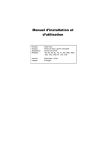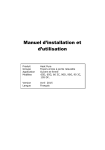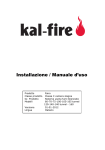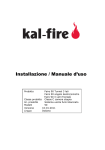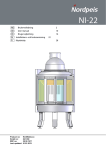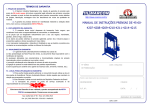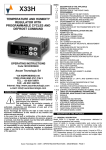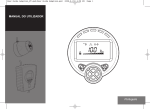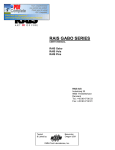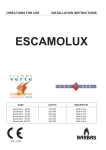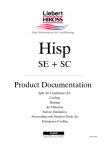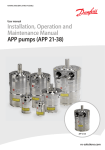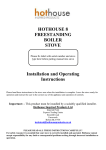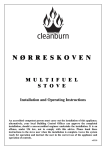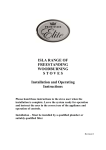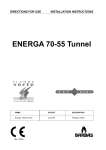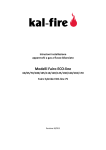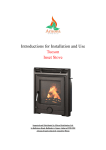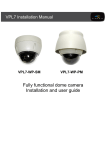Download Installation/User Manual
Transcript
Installation/User Manual Product Product group Application Models Heat Pure Wood burning fireplaces with lifting door Open and closed 45, 60, 65 3S, 70, 71, 85, 90R, 90L, 100, 105, 105 T, 110, 120 Version Language December 2010 English Preface Preface Congratulations on purchasing your Kal-fire fireplace. This manual describes the installation, daily use and maintenance of all the fireplaces from the Heat Pure serie. Read this manual carefully before installing and using the Heat Pure. Please complete the proof of guarantee (appendix C) and keep it with the invoice to verify the purchase date. Always keep this manual close to your Heat Pure An authorised installer will install the Heat Pure fireplace in compliance with the national or local applicable regulations. Check the Heat Pure for transport damage upon delivery. Report any transport damage to the supplier immediately. The supplier cannot be held responsible for any damage as a result of faulty installation. In case any problems occur or if you have any questions concerning the operation of your Heat Pure, please contact your dealer. Your dealer is also the person to contact during the duration of the guarantee period. Kal-fire has installed a telephone helpdesk, to support the technical department of her dealers, to make sure your dealer will be able to advise you in a professional way. All rights reserved. Nothing from this manual may be copied, distributed or translated into other languages, partly or wholly, without prior written permission from Kal-fire. Kal-fire reserves the right to modify this manual without notice. Kal-fire can give no guarantee, neither implicit nor explicit, for this manual. All risks are for the user. Copyright © 2010 Kal-fire B.V. Belfeld, the Netherlands Table of contents 1 Introduction 2 Safety 1 2 3 Mounting and installation 9 2.1 2.2 2.3 2.4 CE-marking ..................................................................... 2 Safety instructions installer ................................................ 2 Safety instructions user ..................................................... 3 Safety precautions ............................................................ 4 3.1 Check before building in/mounting ...................................... 9 3.2 Check flue ..................................................................... 11 3.3 Placing the appliance....................................................... 12 3.4 Supply of combustion air ................................................. 15 3.5 Supply of convection air .................................................. 18 3.6 Chimney/flue connection ................................................. 21 3.7 Mounting the demper ...................................................... 25 3.8 Adjusting the feet ........................................................... 25 3.9 Baffle plate .................................................................... 29 3.10 Finish Heat Pure 65 3-sided ............................................. 34 4 Preparing for use 38 5 Lighting the Heat Pure 40 6 Maintenance 52 7 Trouble shooting 58 4.1 Type of wood ................................................................. 38 4.2 Storing the wood ............................................................ 39 4.3 Ventilation ..................................................................... 39 5.1 5.2 5.3 5.4 5.5 5.6 5.7 Lighting the Heat Pure for the first time ............................. 40 Opening the door............................................................ 40 Air regulation ................................................................. 41 Using the Heat Pure with an open or closed door ................. 42 Igniting the Heat Pure ..................................................... 43 Optimal heat output ........................................................ 47 Operation the demper (optional) ....................................... 51 6.1 6.2 6.3 6.4 Keeping clean panes ....................................................... 52 Cleaning the pane........................................................... 52 Cleaning the grate .......................................................... 56 Maintenance .................................................................. 57 APPENDIX A: EG-declaration of compliance APPENDIX B: Dimension diagrams APPENDIX C: Guarantee 1. Introduction 1 Introduction The wood burning, built in fireplace you have purchased from the Heat Pure line manufactured by Kal-fire, is guaranteed to provide a lifetime of heating satisfaction. The Heat Pure line has the following models: • Heat Pure 45 • Heat Pure 60 • Heat Pure 65 3 sided (65 3S) • Heat Pure 70 • Heat Pure 71 • Heat Pure 85 • Heat Pure 90 corner right (90R) • Heat Pure 90 corner left (90L) • Heat Pure 100 • Heat Pure 105 • Heat Pure 105 tunnel (105T) • Heat Pure 110 • Heat Pure 120 Symbols used In this manual Kal-fire uses a number of symbols. These symbols indicate possible damage to the product and/or a life threatening situation, if the procedures are not observed and followed carefully. Warning of danger. Warning of fire hazard through the presence of flammable substances or a warning of high temperatures. 1 2. Safety 2 Safety 2.1 CE-marking The appliance has been approved according to the CE standard EN13229-A2. Every appliance that leaves the factory has been tested for functionality according to the Kal-fire quality standards. The national Building Regulations, Fire Regulations and the municipal regulations apply to this product. 2.2 Safety instructions installer • • • An authorised installer will connect the Heat Pure in compliance with the national and/or local applicable regulations. Check if the Heat Pure functions correctly immediately after the installation. Take the necessary preventive measures, by using noncombustible material, in order to prevent overheating of floor, boards or walls close to the Heat Pure. 2 2. Safety 2.3 Safety instructions user • The Heat Pure wood fire is only intended for use as an additional heat source. • Careful! The exterior of the fireplace can become hot during use. 1 2 4 3 • • • Nr. 1: The distance between any built-in furniture and the fireplace, should be at least 5 cm. Nr. 2: The distance between any wall-, floor- and /or ceiling material should be at least 1 cm. Nr. 3+4: Make sure that curtains, furniture and/or other combustible materials are at least 100 cm removed from the Heat Pure. If a fireguard is used, this distance must be at least 40 cm. 3 2. Safety 2.4 Safety precautions • • • Insulation material must comply with the national applicable quality standards; this material should, amongst others, be resistant to high temperatures (minimum 700 °C), in order to avoid strong odour development during combustion. Use ceramic fibre panels or hard panels made from mineral wool to prevent loose particles of insulation material circulating in the convection system. Prevent any insulation material covering the convection air inlet. Attach the insulation material firmly, to prevent it from slipping. 4 2. Safety Table 1: Prescribed insulation thickness to combustible materials Inspection Mineral wool (AGI Q 132) Side panel (cm) Roof (cm) Base (cm) Rear panel (cm) Side panel (cm) Roof (cm) Base (cm) Rear panel (cm) Side panel (cm) Roof (cm) Base (cm) Rear panel (cm) Side panel (cm) Roof (cm) Base (cm) Promasil Rear panel (cm) Heat Pure Isorath 1000 45 5 5 9 * 2,6 2,7 5,3 * 2,0 2,1 4,1 * 5 5 9 * 60 10,6 10,5 9 * 8,7 8,6 7,4 * 6,7 6,7 5,7 * 11 11 10 * 65 3Z 5 5 9 * 2,6 2,7 5,3 * 2,0 2,1 4,1 * 5 5 9 * 70 10 10 9 * 2,6 2,7 5,3 * 2,0 2,1 4,1 * 5 5 9 * 71 13,5 10,1 11,9 * 11,0 8,3 9,7 * 8,6 6,4 7,6 * 14 14 13 * 85 15,5 12,3 11,3 * 12,7 10,1 9,2 * 9,9 7,8 7,2 * 16 13 12 * 90R/L 5 5 9 * 2,6 2,7 5,3 * 2 2,1 4,1 * 5 5 9 * 100 10 10 9 * 2,6 2,7 5,3 * 2 2,1 4,1 * 5 5 9 * 105 15,5 13,5 12,1 * 12,7 11,0 9,9 * 9,9 8,6 7,7 * 16 14 13 * 105T 10 - 9 * 2,6 - 5,3 * 2 - 4,1 * 5 - 9 * 110 9,4 8,4 9,3 * 7,7 6,9 7,6 * 6,0 5,3 5,9 * 10 9 11 * 120 9,4 8,4 9,3 * 7,7 6,9 7,6 * 6,0 5,3 5,9 * 10 9 11 9,4 Type The floor, on which the Heat Pure is placed, must be made from non-combustible material, as hot ashes and sparks may fall onto the floor. 5 2. Safety 2.4.1 Installation of the Heat Pure 45, 100 and Heat Pure 105 tunnel in combination with combustible materials (e.g. a wooden wall) When installing the Heat Pure 45, the Heat Pure 100 and the Heat Pure 105 tunnel pay attention to the distance to combustible building materials: Combustible building materials behind (and in the case of the HP 45 next to, if the appliance is built into an alcove) must be shielded/insulated as shown in the drawing below. Heat Pure 45 and 100 Combustible material Combustible material Insulation Insulation Combustible materials must be shielded by insulation material with a minimum thickness of 5 cm. The distance from the back of the Heat Pure to the insulation material must be a minimum of 10 cm. The distance of 10 cm to the insulation must also be observed for combustible material within the housing/cladding of the built in appliance. 6 2. Safety Heat Pure 105 Tunnel Combustible material Combustible materials must be shielded by insulation material with a minimum thickness of 10 cm. The distance from the back of the Heat Pure to the combustible material must be a minimum of 30 cm. Insulation Ensure that curtains, furniture and/or other combustible materials are at a distance of minimum 150 cm from the appliance. * The floor the Heat Pure is placed on must be made of noncombustible materials. The (combustible) floor in front of the door opening must be protected (30 cm on both sides and 50 cm in front of the appliance). 2.4.2 Prescribed materials Insulation Use mats, plates or strips made from silicate insulation materials (stone, clinkers, ceramic fibres); construction class A1 according to DIN 4102 Part 1, with an upper limit temperature of at least 700°C, tested according to DIN 52271 and a nominal density of 80 kg/m. These materials need to have a corresponding insulation material registration number, according to AGI-Q 132. This number may not include the combination “99”. 7 2. Safety For as far as this insulation layer is not kept away from walls, claddings or adjoining plates, attachments must be mounted at a mutual distance of max. 33 cm. Other insulation materials, consisting of, for example, covering concrete or mineral base materials, must have a General Urban Development Permit of the German Institute of Building Technology (DIBt). For further details, see DIN 18895 resp. EN 13229/DIN 18160. Replacement insulation materials have various heat index values, depending on the thickness of the insulation material. The required thickness of the insulation material can be calculated from the graph delivered by the manufacturer. Some heat insulation materials can be used for preconstruction and heat insulation, in order to considerably reduce the built-in depth. Cover heat insulating materials made from stone and clinker fibre so they are not subject to wear, otherwise loose particles may be blown by the airflow into the mounting area. Other heat insulation plates may be supplied wear proof from the factory. Floors The floor, on which the Heat Pure is placed, must have sufficient load bearing capacity (for the weight of the Heat Pure, see table 4). 8 3. Mounting and installation 3 Mounting and installation 3.1 Check before building in/mounting 3.1.1 Heat Pure 45, 60, 70, 71, 85, 100, 105, 105T, 110, 120 1. 2. 3. 4. 5. Check immediately upon arrival, if the products supplied are complete and undamaged. Report any damaged or missing items to the supplier immediately. Remove the transport security (screws with yellow sticker on the front of the convection casing). Check the following parts for correct working: - Lifting door up and down - Forward tilting action of door for cleaning - Air control - Adjustment feet - Any demper with control button (accessories) - Any aeration valves (accessories) Hand the installation/users manual personally to the user of the Heat Pure. Test the internal fresh air valve for correct working. This valve is situated on the rear of the Heat Pure, behind the fresh air connection. When the door is closed, the fresh air flows into the combustion chamber via the air slide valve. When the door is opened, the fresh air flows into the combustion chamber via the convection casing and outlet openings. 9 3. Mounting and installation 3.1.2 Heat Pure 65 3-sided and Heat Pure 90 corner 1. 2. Check immediately upon arrival if the products supplied are complete and undamaged. Report any damaged or missing items to the supplier immediately. Remove the transport security (Two screws in the convection duct with yellow sticker on the rear of the convection casing). Heat Pure 90 corner Heat Pure 65 3-sided 3. 4. 5. Check the following parts for correct working: - Lifting door up and down - Opening and closing the design doors - Forward tilting action of door for cleaning - Air control - Adjustment feet - Any demper with control button (accessories) - Any aeration valves (accessories) Hand the installation/users manual personally to the user of the Heat Pure. Test the internal fresh air valve for correct working. This valve is situated on the rear of the Heat Pure, behind the fresh air connection. When the door is closed, the fresh air flows into the combustion chamber via the air slide valve. When the door is opened, the fresh air flows into the combustion chamber via the convection casing and outlet openings. 10 3. Mounting and installation 3.2 Check flue In order to guarantee correct functioning, we advise you to test/ignite the Heat Pure at the earliest possible opportunity (before it has been completely built-in) (see Chapter 5 Lighting the fireplace). Why? • • • This will allow you to decide if an external demper is necessary. The enamel can also cure before the surround is finished. Allowing the enamel to cure will also cause less nuisance for the end user. This gives you the chance to find out in an early stage, whether or not the fireplace-flue combination is working correctly. Checklist (to be executed) when using the fireplace 1. 2. 3. 4. Check the flue for proper functioning; minimum required draught (suction) is 12 Pa. Test the air slide valve for proper functioning; this will work after the fire has burnt for 50 minutes: (see chapter 3.3.1) - extreme right position = maximum supply of combustion air - extreme left position = air supply closed; the flames will slowly extinguish. If the flames do not react, or do not react enough, to the change in the air slide position, it may be worthwhile considering installing an external demper on the Heat Pure. After a while close all windows and doors and ensure that all appliances that remove air from the home, such as cooker hoods, fans etc. are switched off. Check if the appliance can be used with an opened door (no smoke trickles back into the room). (see chapter 3.3) Use a little smoke to check for correct supply and exhaust of convection air. 11 3. Mounting and installation 3.3 Placing the appliance The appliance may not be placed in the following situations: • • • • in stairwells, with the exception of buildings with no more than two dwellings; in entrance halls with public access; in rooms where flammable or explosive substances or mixtures are processed, stored or manufactured; in rooms or dwellings where air is extracted by airconditioning or with air heating using fans, with the exception of the following cases where a risk free functioning of the Heat Pure is safeguarded: - the installation only circulates air in the room; - the installation has reliable safety precautions, so that over pressure is automatically created in the room where the Heat Pure is installed; - the combustion air flow of the Heat Pure and the volume flows of ventilating installations in the room and the rooms connected by ventilation ducts, create an under pressure that remains below 0.04 mbar. ATTENTION: This situation must also be safeguarded if easily accessible control equipment used for the ventilating installation is moved or removed. 12 3. Mounting and installation 3.3.1 Working combustion air If used with a closed door, the Heat Pure takes the combustion air directly from the connection at the rear (A) or base (A’) of the Heat Pure. This combustion air is guided into the combustion chamber via de air control (B) and the primary thermostat (C), where it is used as primary or secondary combustion air. Primary combustion air (P) The thermostat regulates this air flow automatically. When the Heat Pure is cold the thermostat ensures that air enters the combustion chamber via the lower spoiler. As the Heat Pure warms up, the air flow will gradually decrease. After approximately 50 minutes, the Heat Pure is so warm, that this air flow stops altogether. The primary air control is 100% automatic and cannot be influenced by yourself. Secondary combustion air (S) The air flow is regulated manually via the operating feature to the right of the appliance. Via risers to the left and right of the combustion chamber, this air is warmed up and guided to the combustion chamber via the upper spoiler. The secondary air flow is used to regulate the flames and to keep the glass door clean. This air flow may therefore never be completely closed off. 13 3. Mounting and installation If used with an open door, the air need of the Heat Pure changes. The opening at the front will cause large volumes of air to be sucked into the appliance. This air will be taken from the room the appliance is installed in. With an opened door, the built-in valve ensures that the passage to the combustion chamber is closed (see figure). The connected air is re-routed to the convection casing, where the air is warmed before it flows into the room. This air then becomes available in the room where the appliance is installed so it can be used in the combustion process. Detail ’’valve open’’ Detail ‘‘valve closed‘‘ 14 3. Mounting and installation 3.4 Supply of combustion air The appliance must have enough outside air to ensure problem free ignition. If lower values are established based on the calculated volume of combustion air, building in the appliance is for the risk of the installer. The Heat Pure has a built-in air supply valve; in normal situations no extra air valve is required. In situations where the side gable is subjected to frequent high winds or where there are large indoor/outdoor pressure differences, it is advisable to mount an extra air valve. In that case the valve must be clearly marked to indicate the open and closed position. Inform the users about the function and working of the valve(s). Some air valve manufacturers use plastic sleeves. Mount these outside the heat radiation range of the Heat Pure. Ensure that the fresh air actually is outside air. For example, if the combustion air originates from a cellar, this cellar must have sufficient air vents to ensure that any extracted air is replaced by fresh, outside air. Ensure that the gratings are placed so, that they cannot become blocked. 15 3. Mounting and installation 3.4.1 Fresh air connection base or rear (Heat Pure 45, 60, 70, 71, 85, 90R, 90L, 100, 105, 105T, 110, 120) The standard for the Heat Pure, is that the fresh air connection is situated on the rear. This connection can be relocated to the base. Method 1. Demount the connecting collar at the rear of the Heat Pure. 2. Demount the closing plate at the base of the Heat Pure. Mount the closing plate in the former position of the connecting collar. 3. Mount the connecting collar on the base of the Heat Pure in the former position of the closing plate. 3.4.2 Fresh air connection Heat Pure 65 3-sided The Heat Pure 65 3-sided will be installed with at least 2 fresh air connections (2x Ø150 mm). 16 3. Mounting and installation 3.4.3 Fresh air connection without connecting collar (Heat Pure 45, 60, 70, 71, 85, 100, 105, 105T, 110, 120) If there is not enough space for the connection collar, you can demount this and the air connection using a built construction. In this case, the Heat Pure is positioned on or against an opening for fresh air. Use a ceramic cord to seal off the transition between the Heat Pure and the constructed opening. (Available as an option) Examples: • The Heat Pure is positioned against an opening to a cellar. • The Heat Pure is positioned against an outside wall, which has an opening to the outside air. Kal-fire connection kit (optional) • a ceramic cord to fill gaps of max. 2 cm. • metal strips to attach the cord to the Heat Pure. 17 Ceramic cord 3. Mounting and installation 3.5 Supply of convection air The Heat Pure is surrounded by a convection casing, that warms up the room in a constantly pleasant and efficient manner. For this system to operate to its maximum effect, a convection set is required. This optional convection set consists of: Heat Pure 45 and 60 • 4 flexible aluminium hoses Ø150 mm 1.25 m: 2 hoses of 2.5 m which must be divided in half, in order to get a total of 4 hoses. • 8 clamping strips. • 4 gratings: outer dimensions 20 x 20 cm, recess dimension 16.5 x 16.5 cm, with connection collar Ø150 mm. • Mantel iron; this must be sawn to the correct size. • Roll of felt to create an expansion joint between the metal of the mantel iron and the surround. Heat Pure 65 3-sided, 90R and 90L • 4 flexible aluminium hoses Ø150 mm 1.25 m: 2 hoses of 2.5 m which must be divided in half, in order to get a total of 4 hoses. • 8 clamping strips. • 4 gratings: outer dimensions 20 x 20 cm, recess dimension 16.5 x 16.5 cm, with connection collar Ø150 mm. For the Heat Pure 65 3-sided and the Heat Pure 90 corner models, the mantel iron and roll of felt should be ordered separately, it’s not included in the convection set. This convection set is ordered separately to the Heat Pure. Instead of a grating, openings (for example recessed plinths) can be used. Do not reduce the convection openings. Place all of the gratings / openings, both upper and lower, to facilitate the natural circulation. The gratings / openings should be situated in the same pressure area (the same room) as the Heat Pure. 18 3. Mounting and installation Heat Pure 70, 71, 85, 100, 105, 105T, 110 and 120 • 8 flexible aluminium hoses Ø150 mm 4x 1.25 m long and 4x 0.62 m. 2 hoses of 2.5 m which must be divided in half, in order to get a total of 4 hoses and 1 hose of 2.5 m which must be divided into 4. • 16 clamping strips. • 4 gratings: outer dimensions 35 x 20 cm, recess dimension 33 x 16.5 cm, with 2 connection collars Ø150 mm each. • Mantel iron; this must be sawn to the correct size. • Roll of felt to create an expansion joint between the metal of the mantel iron and the surround. Method when using gratings Ensure that, at the base, there is sufficient supply for the cold convection air from the room (see table below). At the top connect the gratings to the outlet openings of the warm convection air (see table below). Table 2: Through put openings for convection air Inlet convection air 2x Ø150 mm Heat Pure 65 3S, 70, 71, 85, 90R, 90L, 100, 105, 105T, 110, 120 4x Ø150 mm 355 cm2 705 cm2 Outlet convection air 2x Ø150 mm 4x Ø150 mm Heat Pure 45, 60 2 705 cm2 355 cm Attention! When mounting the gratings, ensure they are placed in such a position, that they cannot become blocked. Method when using openings If you do not want to use gratings, openings at the top and base of the surround (chimneybreast) are also sufficient. For through put openings, see Table 2. These openings serve the same function as the gratings and supply and extract the convection air. We advise you, to place tubes or hoses on the outlet openings. This makes the convection system (just a little) more powerful and the heat is guided more easily to the openings. If you do not use the recommended convection set, this may damage the Heat Pure by overheating. The result may be soiled walls and ceilings in the room. There is always a risk of discolouration to walls and ceilings, but this risk can be considerably reduced, by correctly ventilating the room. 19 3. Mounting and installation Mount the gratings at a distance of at least 30 cm from the ceiling or wall. Ensure there are no flammable materials closer than 30 cm next to and 50 cm above the gratings. 20 3. Mounting and installation 3.6 Chimney/flue connection The Heat Pure is connected to an existing flue. The operational height of the flue must be minimum 4.5 meter (draught 12 Pa), calculated from the point at which the flue duct is joined to the Heat Pure. Take local legislation and environmental factors into account. Table 3: Chimney/flue diameter and firebox per model Firebox (in mm) Width/height Firebox (cm2) Minimum fresh air supply Flue Ø (mm) Type 45 415 / 454 1884 1x Ø 150 mm 150 Type 60 545 / 470 2560 1x Ø 150 mm 180 270 / 460 (2x) 681 / 460 4323 2 x Ø 150mm 250 305/665 2028 2 x Ø 150 mm 180 Type 71 655 / 580 3800 2 x Ø 150 mm 250 Type 85 795 / 360 2860 2 x Ø 150mm 200 Type 90R/L 870 / 460 390 / 460 5796 2 x Ø 150mm 250 Type 100 570/ 926 5278 2 x Ø 150mm 250 Type 105 995 / 440 4380 2 x Ø 150mm 250 995 / 440(2x) 4380(2x) 2 x Ø 150mm 250 Type 110 1045 / 340 3555 2 x Ø 150mm 250 Type 120 1145 / 340 3895 2 x Ø 150mm 250 Heat Pure Type 65 3Z Type 70 Type 105T 21 3. Mounting and installation If you want to use a flue diameter that differs from those shown in table 3, use the formula below to calculate a possibly smaller diameter. F sch = F so H × e sch Fsch Fso Hsch e flue section in cm2 surface firebox in cm2 height of flue in metre measured from the upper side of the Heat Pure influence factor between 0.2 and 0.6 determined by the flue quality: 0.2 with a perfect flue, straight above the Heat Pure; 0.6 with connection less than 45°. Permitted reduction: - flue Ø150 Æ reduction not permitted - flue Ø180 Æ maximum reduction 30 mm - flue Ø200 Æ maximum reduction 20 mm - flue Ø250 Æ maximum reduction 50 mm After reducing the flue, it is no longer possible to use the Heat Pure as an open fire place. Reduction is permitted immediately behind the demper/ connection collar, but not any deeper into the flue. At doubt, always use the connection diameter indicated on the Heat Pure. • • • • • Avoid horizontal runs; one extension may be placed with adjustable elbows with maximum one change of direction of 45°. Kal-fire advises you to insulate the flue; this will reduce the risk of the smoke condensing and will improve the draught. Use the Kal-fire stainless steel insulated flue duct for this purpose. Kal-fire advises you not to use larger flue diameters than the connection present on the Heat Pure. Using a larger flue diameter can result in the following problems: Too fast and uncontrolled combustion; Irregular flames; Reduced heat output. Use a draught hood if there is a flue with a (too) strong draught. If the flue has too much upward draught, this may result in a too quick, uncontrolled combustion, irregular flames and rapid soiling of the glass door. Use of different flue diameters to those indicated, is entirely for the risk of the installer; when the door is opened, smoke may escape back into the room or it may be more difficult to ignite the Heat Pure. 22 3. Mounting and installation • • 3.6.1 Take factors in the surrounding environment into account which could cause a strong draught in the flue. For example, frequent high winds, which require a demper to be mounted. Pay attention that it is also possible to sweep the chimney in the connection piece. Rear connection (Heat Pure 45, 60, 70, 71, 85, 100, 105, 105T, 110, 120) The Heat Pure is delivered as standard, with the flue exit connection on the top of the appliance. This connection can be converted to create a flue exit connection at the rear of the appliance. 1 4 2 3 6 5 Figure 1 Converting a top flue exit into a rear flue exit (6 steps) 23 3. Mounting and installation 1. 2. Demount the upper part of the convection casing. The connection piece is now visible and the four bolts can be unscrewed. Turn the connecting piece 180°. Press the punched cover out of the convection casing; this cover is used to close off the upper connection. Mount the upper part back onto the Heat Pure. Place the cover on the opening on the top. Continue with the connection of the Heat Pure. 3. 4. 5. 6. 7. Attention: • Make sure that all the horizontal parts of the rear connection can be reached for cleaning. • The horizontal part may be maximum 50 cm. 3.6.2 Reducer ring The Heat Pure is delivered as standard with a reducer ring. This ring can be used to connect various flue systems to the Heat Pure. Figure 2 Reducer ring Table 4: Diameter chimney connection collar Connection collar Heat Pure (mm) A inn. (mm) B inn. (mm) C inn. (mm) 45 Ø148 ±2 Ø156 ±1 Ø136 ±1 Ø152 ±1 60, 70 Ø178 ±2 Ø186 ±1 Ø166 ±1 Ø182 ±1 85 Ø198 ±2 Ø206 ±1 Ø186 ±1 Ø202 ±1 65 3S, 71, 90R, 90L, 100, 105, 105T,110, 120 Ø248 ±2 Ø256 ±1 Ø236 ±1 Ø248 ±1 Heat Pure Type 24 3. Mounting and installation 3.7 Mounting the demper The Heat Pure is delivered as standard without a demper. A demper can be used to influence the degree of draught (suction) in the flue. With the Heat Pure an external demper can be added. If there is too much suction in the flue, we advise you to use a demper. The amount of draught can be tested when you ignite the fire to test the operation of the appliance. Pay extra attention to this aspect, if the flue is longer than 7 metres. Normally the Heat Pure can be controlled well using the air regulation (see section 5.3). Attention • Make sure that the position of the demper is visible for the end user. For this purpose most of the operating knobs have a position indication (Open = Auf or + , Closed = Zu or -). • Check the functioning of the demper before completing the installation of the Heat Pure. • Make sure that the end user is familiar with way the demper functions. 3.8 Adjusting the feet Heat Pure 45, 60, 70, 71, 85, 100, 105, 105T, 110, 120 Rough adjustment Unscrew the two bolts and roughly set the height. Range 38 cm. Do not forget to place the two bolts back. Fine adjustment Screw the adjustment foot bolt to set the precise height. Range 5 cm. Use this method to set the Heat Pure perfectly level. 25 3. Mounting and installation Heat Pure 65 3–sided, 90 corner model Fine adjustment Screw the bolt at the adjustment foot to set the precise height. Range 5 cm. Use this method to set the Heat Pure perfectly level. 26 3. Mounting and installation Fireplace surround Materials with the following characteristics can be used to create the surround around the Heat Pure: − resistant to high temperatures, minimum 700 °C. − free from materials which can cause fumes and odour nuisance. − dimensionally stable, even after lengthy exposure to high temperatures. 1. The surround must have no direct connection to the Heat Pure; it must be self supporting. 2. Seal the joints between the Heat Pure and the surround, using heat resistant glass fibre or ceramic cord. 3. Use the Kal-fire mantel iron for easy and stable mounting of the span above the door of the Heat Pure. Never attach this mantel iron to the actual Heat Pure, but to the side of the surround or use tie rods to attach it to the ceiling or wall. 4. Ensure that the thickness of the surround above the door of the Heat Pure does not exceed 11 cm, otherwise the Heat Pure will be too deeply recessed and it will be difficult to operate/clean the door. 5. Finish the surround using materials that do not contain any plastic substances. High temperatures may cause plastic to discolour. 6. Before completely closing off the surround, ensure that the inside of the surround is clean and free of dust. Preferably use a vacuum cleaner to clean the inside of the surround. If you fail to do his, particles of dust may cause problems in the air flow of the convection system. 7. The Heat Pure is surrounded by a metal strip which facilitates the join between the surround and the Heat Pure. These metal strips can be hidden from view on the front; all the lines of the surround then merge into the finishing strips. The side strips can be demounted inwards, so the guide can be accessed in the event of maintenance. 27 3. Mounting and installation 3.8.1 Practical examples of connection: combustion air and convection Situation 1 - Recommended situation The combustion air is connected directly to the Heat Pure from outside. The outside air is not in contact with the room the appliance is installed in or with the chimneybreast. The convection system is also connected directly to the Heat Pure. There are no open connections between the interior of the chimneybreast and the room in which the appliance is installed. Situation 2: The combustion air is connected directly to the Heat Pure from outside. The outside air is not in contact with the room the appliance is installed in or with the chimneybreast. The convection system is only in contact to the room in which the appliance is installed. Situation 3: The combustion air cannot be connected directly to the Heat Pure; this air must be taken from the room the appliance is installed in. This mainly occurs in an existing situation, in which the combustion air can only be taken from the room the appliance is in. The convection system must then be physically separated from the combustion air; connect the lower and upper convection gratings directly to the Heat Pure. The combustion air reaches the Heat Pure through extra openings in the chimneybreast. See Technical Specifications (table 4) for the through put of these openings. The convection connections at the top of the appliance must be connected at all times. 28 3. Mounting and installation 3.9 Baffle plate Heat Pure 45 The Heat Pure has a removable baffle plate. This baffle plate is situated above the smoke hood just below the heat exchanger. The baffle plate ensures optimal an combustion. In the following situations, it may be necessary to remove the baffle plate(s) or decrease it’s the size. • Bad exhaust of the flue gasses • Condensation in the flue duct If necessary, you can adjust the baffle plate as follows: 1. Remove the baffle plate and see if this solves the problem. If the problem still occurs, then something else is the cause. If removing the plate solves the problem, proceed with the next step. 2. Use a saw or knife to cut away a strip of 1 cm wide at the front of the baffle plate. Do not remove too much. The baffle plate must still be able to rest on the bracket. A maximum of 6 cm can be cut away from the baffle plate. 3. In certain situations it may be necessary to remove the baffle plate completely. 29 Baffle plates 3. Mounting and installation Heat Pure 60, 70, 71, 85, 105, 110 120 The Heat Pure has a removable baffle plate. This baffle plate is situated above the smoke hood just below the heat exchanger. With the larger Heat Pure Models this plate consists of several parts. The baffle plate ensures an optimal combustion. In the following situations, it may be necessary to remove the baffle plate or decrease it’s the size. • Smoke return when the Heat Pure starts • Condensation in the flue duct If necessary, you can adjust the baffle plate as follows: Baffle plate 1. Remove the baffle plate and see if this solves the problem. If the problem still occurs, then something else is the cause. If removing the plate solves the problem, proceed with the next step. 2. Use a saw or knife to cut away a strip of 1 cm wide at the front of the baffle plate. Do not remove too much. The baffle plate must still be able to rest on the bracket. A maximum of 6 cm can be removed from the baffle plate. 3. In certain situations it may be necessary to remove the baffle plate entirely. 30 3. Mounting and installation Heat Pure 65 3-sided The Heat Pure 65 3-sided has two removable baffle plates. These baffle plates are situated above the smoke hood just below the heat exchanger. The baffle plate ensures an optimal combustion. In the following situations, it may be necessary to remove the baffle plate(s) or decrease it’s the size. • Smoke return when the Heat Pure starts • Condensation in the flue duct If necessary, you can adjust the baffle plates as follows: 1. Remove the lower baffle plate and see if this solves the problem. If the problem still occurs, then also remove the upper baffle plate. If the problem still isn’t solved, then something else is the cause. If removing the plate(s) solves the problem, proceed with the next step. 2. Baffle plate Cut away a strip of 3 cm wide, at the front and rear of the baffle plate. If necessary, do this for both baffle plates. A 3-sided fireplace is always a more sensitive product than a fireplace with a door at the front, particularly when used with an open door. If the Heat-Pure 65-3-sided is used as an open fireplace, some smoke may flow back into the room- even if both baffle plates have been removed. This may have a number of causes: Insufficient pull in the chimney duct, The air flow patterns in the room where the 3-sided fireplace has been installed, Too low ignition temperature. 31 3. Mounting and installation Heat Pure 100 The Heat Pure has a removable baffle plate. This baffle plate is situated above the smoke hood just below the heat exchanger. The baffle plate ensures optimal an combustion. In the following situations, it may be necessary to remove the baffle plate(s) or decrease it’s the size. • Bad exhaust of the flue gasses • Condensation in the flue duct If necessary, you can adjust the baffle plate as follows: 1. Remove the baffle plate and see if this solves the problem. If the problem still occurs, then something else is the cause. If removing the plate solves the problem, proceed with the next step. 2. Use a saw or knife to cut away a strip of 1 cm wide at the front of the baffle plate. Do not remove too much. The baffle plate must still be able to rest on the bracket. A maximum of 6 cm can be cut away from the baffle plate. 3. When used as an open fire place, the baffle plates should be removed completely. 32 Baffle plates 3. Mounting and installation Heat Pure 105 Tunnel The Heat Pure 105 Tunnel has several removable baffle plates. These baffle plates are situated above the smoke hood just below the heat exchanger. The baffle plate ensures an optimal combustion. In the following situations, it may be necessary to remove the baffle plate or decrease it’s the size. • Smoke return when the Heat Pure starts • Condensation in the flue duct If necessary, you can adjust the baffle plate as follows: Baffle plates 1. Remove all baffle plates and see if this solves the problem. If the problem still occurs, then something else is the cause. If removing the plate solves the problem, proceed with the next step. 2. Use a saw or knife to cut away a strip of 1 cm wide at the front of the baffle plate. Do not remove too much. The baffle plate must still be able to rest on the bracket. A maximum of 6 cm can be removed from the baffle plate. 3. In certain situations it may be necessary to remove the baffle plate entirely. The Heat Pure 105 tunnel is not suitable to be used as an open fire place. 33 3. Mounting and installation 3.10 Finish Heat Pure 65 3-sided and Heat Pure 90 corner Finish upper side Space of min. 2mm The surround above the Heat Pure 65 3-sided and Heat Pure 90 corner, must have at least 2 mm of play, in relation to the trim above the door. Finish side Cut through C-C Surround Make sure the surround / plastering is not sticking out with respect to this converted side. This will prevent that the little doors on both sides of the Heat Pure 65 3-sided and 90 corner are obstructed. 34 3. Mounting and installation Finish front The front of the Heat Pure 65 3-sided and 90 corner can be finished in two ways: 1. Mount the platform under the steel design trim. Steel design trim Platform The platform may not touch the steel design trim. 35 3. Mounting and installation Table 5: Technical data Heat Pure: Indication plate Inspection body 45 60 65 3Z 70 71 85 P8-0632009 EZ/06/1961 /04 P8-2872008 P8-0862009 EZ/06/196 /03 EZ/06/1961 /02 1004 0608 1004 1004 0608 0608 Norm EN13229 A2 EN13229 A2 EN13229 A2 EN13229 A2 EN13229 A2 EN13229 A2 Output (kW) 4,7 – 9,3 13,0 7,5 -15,0 4,8 –9,7 15,0 13,0 Flue gas mass flow (g/s) 6.8 9,9 12,5 8,6 13,2 10,9 Heat output (%) 86 81 83 84 72 76 Flue gas temperature (°C) 270 251 229 240 328 272 CO at 13%O2 (%) 0,10 0,09 0,12 0,12 0,09 0,12 CO2 content (%) 11.1 10,58 10,2 9,2 9,11 9,24 Dust content at 13%O2 (mg/nm3) 36 45 19 62 19 16 NOx at 13%O2 (mg/nm3) 150 109 140 105 100 125 CnHm at 13%O2 (mg/nm3) 58 61 100 117 48 63 Min. flue draught (Pa) 12 11,6 12 11 12,2 12,7 Insulation side panel (cm) (AGI-Q 132, table 1) 5 11 3,3 10 14 13 Insulation rear panel (cm) (AGI-Q 132, table 1) 5 11 3,2 10 14 16 Insulation base (cm) (AGI-Q 132, table 1) 0 0 0 0 0 0 Insulation roof (cm) (AGI-Q 132, table 1) 9 10 6,5 9 13 12 ¢150 ¢180 ¢250 ¢180 ¢250 ¢200 Combustion air connection (mm) 1x Ø150 1x Ø150 2x Ø150 2x Ø150 2x Ø150 2x Ø150 Convection connection inlet (mm) 2x Ø150 2x Ø150 4x Ø150 4x Ø150 4x Ø150 4x Ø150 Convection connection outlet (mm) 2x Ø150 2x Ø150 4x Ø150 4x Ø150 4x Ø150 4x Ø150 180 226 270 210 271 257 Flue connection (mm) Weight (kg) 36 3. Mounting and installation Table 5: Technical data Heat Pure: 90R/L 100 105 105T 110 120 Indication plate P8-0482010 P8-0662010 EZ/06/1961/ 01 P8007/2010 EZ/07/22 13/02 EZ/07/2213/ 01 Inspection body 1004 1004 0608 1004 0608 0608 Norm EN13229 A2 EN13229 A2 EN13229 A2 EN13229 A2 EN13229 A2 EN13229 A2 Output (kW) 7,5-14,9 8,8-17,6 17,0 8,8 – 17,6 16,5 17 14,95 17,34 14,4 20,87 14,4 14,5 Heat output (%) 80 80 75 78 75 75 Flue gas temperature (°C) 241 255 376 275 350 324 CO at 13%O2 (%) 0,1 0,09 0,08 0,10 0.09 0,11 CO2 content (%) 8,6 8,8 10,16 7,4 9,39 8.,63 Dust content at 13%O2 (mg/nm3) 20 22 65 25 54 44 NOx at 13%O2 (mg/nm3) 138 116 107 150 105 104 CnHm at 13%O2 (mg/nm3) 93 90 30 110 50 70 Min. flue draught (Pa) 13 13 12,2 11 12 12 Insulation side panel (cm) (AGI-Q 132, table 1) 10 5 14 - 8,4 3,3 Insulation rear panel (cm) (AGI-Q 132, table 1) 10 5 16 10* 9,4 3,2 Insulation base (cm) (AGI-Q 132, table 1) 0 0 0 0 0 0 Insulation roof (cm) (AGI-Q 132, table 1) 9 9 13 9 9,3 6,5 ¢250 ¢250 ¢250 ¢250 ¢250 ¢250 Combustion air connection (mm) 2x Ø150 2x Ø150 2x Ø150 2x Ø150 2x Ø150 2x Ø150 Convection connection inlet (mm) 4x Ø150 4x Ø150 4x Ø150 4x Ø150 4x Ø150 4x Ø150 Convection connection outlet (mm) 4x Ø150 4x Ø150 4x Ø150 4x Ø150 4x Ø150 4x Ø150 320 430 328 435 302 335 Flue gas mass flow (g/s) Flue connection (mm) Weight (kg) * see explanation on page 8 37 4. Preparing for use 4 Preparing for use 4.1 Type of wood The Heat Pure built-in fireplace is suitable for burning dry wood. We recommend using only chopped wood, which has not undergone any treatment; MDF, stained or coated wood, and flammable waste should not be used as fuel in the Heat Pure on environmental grounds and to protect the working life of the Heat Pure. The most suitable types of wood are beech, oak and birch. Dry wood (approximately 15% moisture content) is extremely important for a good combustion process. If damp wood is used, the ceramic window pane in the door will become soiled and there is an increased risk of chimney fire. It will also form an environmental nuisance and a nuisance to the neighbours as a result of the excessive smoke/odour that is released (extremely dark smoke). This is why you should always make sure that dry wood is stored suitably. To obtain the ideal moisture content of 15%, the chopped wood often needs to dry outside for a period of 2 to 3 years. If the Heat Pure is lit with an open door, we advise you to use broadleaf wood such as oak, beech and birch. These types of wood do not contain much resin. When burning types of wood that do contain resin, such as pine and larch and fir, a lot of sparks are released. We also discourage the use of hardwood. It is better to mix the different types of wood, for example, by combining broadleaf wood with hardwood. This will benefit the lifespan of the Heat Pure and will create a more attractive play of flames. 38 4. Preparing for use 4.2 Storing the wood All types of wood should be stored for about 2 to 3 years in a dry, protected and well-ventilated area. For example in a lean-to next to the house. A cellar or a garage without good ventilation is not suitable as a storage place for wood. Also, the wood should be stored chopped; otherwise the bark will impede the drying process. Wood often contains insects; therefore do not store the wood in the living room for lengthy periods. 4.3 Ventilation The risk of discolouration can be reduced by effective ventilation in the room where the appliance is installed (see also section 3.5). Below are some tips, from the Dutch decorative heating guild, to avoid discolouration: • The area in which the Heat Pure is situated must be well ventilated. • Minimise the use of candles and oil lamps and keep the wick as short as possible. These ‘decorative touches’ produce considerable amounts of soiling and unhealthy soot particles in your home. • Wait at least 6 weeks before lighting a newly installed masonry mantelpiece or after building work. The building moisture must be allowed to disappear completely from walls, the floor and ceiling. • Avoid smoking. Smoking is not only bad for your health, but cigarette and cigar smoke also contain tar, that will cause deposits on colder and damp walls when heated. • With renovations or new building work, ensure there is extra ventilation to remove volatile solutions from your home. 39 5. Lighting the fireplace 5 Lighting the Heat Pure 5.1 Lighting the Heat Pure for the first time When the Heat Pure is lit for the first time, the enamel on the stove will burn in and cure. This causes nuisance in the form of odour and fumes. Make sure the room is well ventilated. It is advisable to light the Heat Pure during the day, and open all doors and windows in order to reduce the odour nuisance. Enamel that has not yet cured is particularly sensitive. Avoid touching the enamelled parts of the fireplace. Leave the door open, for about 5 cm, the first time the Heat Pure is lit and close the door after it has cooled down. When heated the enamel is soft and will stick sooner. If the door does stick to the Heat Pure, it can be tilted (see section 5.2). 5.2 Opening the door The Heat Pure is equipped with a lifting door. To open the door, place the handle in the opening on the lower right. To do so, use the short pin, attached to the handle. Then lift the handle upwards. The first 3 cm can be quite difficult, because the door has to be pulled out of the lock. After this, it will be easier. The door can be left open in any desired position. The frameless bottom of the door, always gives you have an optimum view of the flames. Operating the air regulation Operating the door Figure 3: end of the key 40 5. Lighting the fireplace 5.3 Air regulation The Heat Pure has two types of air regulation: The primary air is regulated automatically and ensures that the wood is easily ignited. This creates a glowing bed of carbonised wood for an optimal gasification process. After burning for approximately 50 minutes, this valve closes automatically, which will produce a high heat output. When the primary air valve is closed, the air enters the combustion chamber through the top spoiler. This top spoiler also ensures that the window remains clean. When the draught in the chimney exceeds 12 Pascal, and (very) dry wood is being burned, you will be able to keep the window clean for a considerable length of time. However, soiling can occur on the window when the fire is smothered by closing the air regulation. The flames can be regulated by inserting the side of the key into the groove positioned on the right-hand side of the Heat Pure. Use the right side of the handle (figure 3). By moving the key to the left, you will minimise the air supply to the top spoiler; the fire will burn more calmly (provided that the primary air valve has closed automatically). By moving the key to the right, the air supply to the fire will increase and the fire will burn more strongly. 41 5. Lighting the fireplace 5.4 Using the Heat Pure with an open or closed door The Heat Pure can be used as an (open) fireplace or a stove (door closed). The main difference, is that each use has a different air requirement. For this reason, the Heat Pure features a fresh air valve at the rear of the appliance (patent). Advantage: The air required by the flue duct to ensure good constant circulation is always introduced into the Heat Pure or room in the most efficient and comfortable way. When placing the Heat Pure it is always important to take heavy air users into account, such as large ventilation systems and extractor hoods. These products use powerful motors to extract air, the pressure difference built up naturally by a flue is far less. Closed door Open (fireplace) door When the door is open, the heat output will fall to about 20%. The wood consumption will increase; as air has unregulated access to the wood. The advantage is a cosy hearth fire. • Never leave an open fire burn without supervision; any sparks could cause a fire. • Open the demper (if present) completely. • Only use the Heat Pure as an open fireplace if there is enough draught in the flue. • Preferably use the Heat Pure with a closed door. This is better for the environment and the heat output. 42 5. Lighting the fireplace 5.5 5.5.1 Igniting the Heat Pure Igniting the Heat Pure 45, 60, 65 3-sided, 71, 90 R/L and 100 Place a couple of large logs on the base of the appliance and one large log against the rear wall. Place a smaller log on top. Place some firelighters on top. Place some finely chopped wood onto the logs. Open the air regulation completely (position on the extreme right). Ignite the firelighters using a long match. Leave the door slightly open (1-2 cm) for a couple of minutes. When there is a glowing bed, distribute the glowing ashes using poker. Now add more wood (see section 5.6). 43 5. Lighting the fireplace 5.5.2 Igniting the Heat Pure 70, 85, 105, 110 and 120 Place a couple of large logs on the base of the appliance and one large log against the rear wall. Place two pieces diagonally on top. Place some firelighters on the logs. Place some finely chopped wood onto the logs. Open the air regulation completely (position on the extreme right). Ignite the firelighters using a long match. Leave the door slightly open (1-2 cm) for a couple of minutes. When there is a glowing bed, distribute the glowing ashes using poker. Now add more wood (see section 5.6). 44 5. Lighting the fireplace 5.5.3 Igniting the Heat Pure 105 Tunnel Place a log on the base of the appliance with some finely chopped wood on both sides. Place 2 logs diagonally on top of the wood, together with a few firelighters. Use the operating key to open the air regulation completely. (position on the extreme right). When there is a glowing bed, distribute the glowing ashes using a poker. Now add more wood (see section 5.6. Ignite the firelighters using a long match. Leave the door slightly open (1-2 cm) for a couple of minutes. 45 5. Lighting the fireplace Tips • Use enough wood to ignite the Heat Pure: - Heat Pure 45 approx. 2 kg - Heat Pure 60, 65 3-sided, 85 and 90 R/L approx. 4 kg - Heat Pure 71, 100, 105, 110 and 120 approx. 6 kg • When the fire has been lit, leave the door slightly open (1-2 cm) for a few minutes; the wood will catch fire more easily and the flue will be quickly warmed-up. Do not use white spirits, petrol, oil or other liquid fuels. Be aware that weather conditions (air pressure, temperature, wind) can influence combustion. Minimize these influences by adjusting the secondary air supply. 46 5. Lighting the fireplace 5.6 Optimal heat output For optimal heat production we advise you to burn wood according to the instructions below. This will achieve the same performance and emission values, obtained during inspection of the appliances. • Ensure a glowing bed is created (see section 5.5) • Use logs of wood of approximately the same size. The amount differs per type of Heat Pure. See table below. Table 5 Instructions for optimal burning per model Heat Pure: Weight* per log (g) Number of logs Maximum weight* wood per hour (kg) Air regulation open (%) Heat Pure: Weight* per log (g) Number of logs Maximum weight* wood per hour (kg) Air regulation open (%) 45 60 65 3Z 70 71 85 850 850 1300 730 1000 850 2 3 3 3 3 3 2,3 4 4 2,2 5 4 100 100 45 75 50 100 90 R/L 850 100 105 105T 110 120 1200 1300 1100 1300 1300 4 3 3 4 3 3 4 3,6 5,7 5 5 5,2 10 60 100 50 100 100 * Weight for beech 47 5. Lighting the fireplace To get an optimal air mixture, you need to place the logs as follows: Heat Pure 45 Place the two wood logs in a V shape. Heat Pure 60 and 71 Position the logs in an A-shape with the horizontal log at the base. 48 Heat Pure 65 3S, 85, 100*, 105, 110, 120 Position the logs in an A-shape with the horizontal log on top of the two vertical logs. Heat Pure 70 Two logs are 15 to16 cm long. The third log is 33 cm. 5. Lighting the fireplace Heat Pure 90R and 90L Place 4 logs of approx ca. 25cm long in a cross shape in the right or left side of the fireplace. Heat Pure 105 Tunnel Place 4 logs of approx ca. 30cm long in a cross shape in the centre of the fireplace. *Heat Pure 100 The length of the logs is approx. 29cm. The Heat Pure 45 can be used both as an open or closed fireplace. Remove both baffle plates before using the appliance with the door open, to enable correct exhaust of the flue gas. 49 5. Lighting the fireplace Open door use We advise you to keep the door of the Heat Pure 45 door closed, until there is a good glowing bed and the Heat Pure 45 is well heated (high temperature of the skamol plates and in the combustion chamber). This ensures the flue gas is exhausted correctly. If the appliance is used with the door open straight away, there is only a minimum of pull in the chimney. The flue gasses will not be exhausted correctly, but will flow back into the room. When the logs have been burnt, position new logs on the glowing bed in the same way as explained above. Take the amount of wood indicated per hour into account. Heat Pure 70 If the flue duct of the Heat Pure 70 has been reduced (from 180 to 150) the appliance is no longer suitable for use when open. Only open the door of the firebox if strictly necessary (e.g. to add logs). Heat Pure 105 Tunnel The Heat Pure 105 tunnel is not suitable to be used when open. Only open the door of the firebox if strictly necessary (e.g. to add logs). 5.6.1 Topping up with wood To maintain optimal heat output, top up the fire with new wood as soon as the flames have disappeared and the logs are starting to glow (no smoke development). To add new logs, you need to open the door slowly, to prevent smoke escaping into the room because of the sudden draught. Do not add more than 2 to 3 logs (see maximum weight wood, table 5). When the logs are burning strongly, you can close demper (if installed) again. A rule of thumb: 1 kg of wood provides about 4 kW of energy. The Heat Pure is suitable for discontinuous use. This is achieved by burning according to table 5. 50 5. Lighting the fireplace 5.7 Operation the demper (optional) Depending on the situation, an external demper can be connected to the Heat Pure (see section 3.6). Attention! It is not necessary to install a demper in all situations! After the installer has installed the demper, you can operate it using the knob on the side of the surround. When using an original Kal-fire demper, the letters “Auf or +” on the knob show the open position. “Zu or -” is the closed position. Set the required position by turning the knob. The position of the demper depends on the draught in the flue and the way the appliance is being used: When lighting the fire demper fully open. When burning with closed door The demper can be closed to 20-50% which will calm the flames. If you want to top up wood, open the demper completely, before opening the door. When the wood is burning to your satisfaction, you can partly close the demper again. When burning with open door Fully and permanently open the demper. 51 6. Maintenance 6 Maintenance 6.1 Keeping clean panes To keep the panes clean: • Only burn dry wood (with a moisture level of approximately 15% and stored dry and chopped for 2 years). • Open the air supply completely (100%). • Open the demper completely (if present). • Ensure the flue has a minimum draught of 12 Pa. 6.2 Cleaning the pane Heat Pure 45, 60, 70, 71, 85, 100, 105, 105T, 110, 120 1. To clean the pane, press the lifting door down firmly and completely. 2. Place the key in the lock situated in the centre at the top. 3. Turn the lock to the left until you feel resistance. 4. The key can also be slotted into the lip on the upper right and used to pull the door open. 5. The door can now be tilted forward. 6. Before cleaning the pane, allow the material to cool down completely, to prevent any damage. The best way to clean the glass, is to use the Kal-fire window cleaner, available at your dealer. 7. Use a cloth or piece of paper to remove the worst soiling from the pane. 8. Spray the window cleaner onto a cloth or piece of paper and wipe the pane clean. Never spray the window cleaner straight onto the glass! 52 6. Maintenance 9. Wipe over the pane with a damp cloth afterwards, to remove all traces of the detergent used. 10. The deposits will automatically fall into the combustion chamber due to the tilted position of the door. The area in front of the Heat Pure will be kept clean. To close the door again, tilt it back and turn the key to the right. The Heat Pure will be hermetically sealed again by the three-point closure. − Ensure that no detergent fluids makes contact with the sealing cords. This will damage the cords! − Remove persistent soiling by dipping a damp cloth into the ash. Rub the glass with the cloth. − Do not use detergents that contain ammonia. Ammonia will damage the sealing cords. − Ensure that no glowing particles come into contact with the sealing cord. These will damage the cords. 53 6. Maintenance Heat Pure 65 3-sided 1. 2. 3. 4. 5. 6. 7. 8. Before you are going to clean the glass, it has to be completely cooled down, to prevent damage. Press the complete lifting door down firmly. Open both doors, left and right (see image). The closing levers are behind the doors. Pull these lever forwards; they will lock in a horizontal position. The door is released and can be moved forward (see image). Take hold of the door on the left and right and gently pull it forwards. Use a cloth or piece of paper to remove the worst soiling from the glass. Spray the detergent onto a cloth or piece of paper and wipe the glass clean. Never spray the cleaning agent directly onto the glass. Wipe over the glass with a damp cloth afterwards, to remove all traces of the detergent used. 54 6. Maintenance Heat Pure 90 corner right and left 1. 2. 3. 4. 5. 6. 7. 8. 9. 10. Before you are going to clean the glass, it has to be completely cooled down, to prevent damage. Press the complete lifting door down firmly. To open de door use the lever (see picture). Pull down the lever until it is in an vertical position. The door is released and can be moved forward (see image). Take hold of the door on and gently pull it forward. Use a cloth or piece of paper to remove the worst soiling from the glass. Spray the detergent onto a cloth or piece of paper and wipe the glass clean. Never spray the cleaning agent directly onto the glass. Wipe over the glass with a damp cloth afterwards, to remove all traces of the detergent used. To close the door, gently push back the glass. Turn back the lever in its original horizontal position. Close the flap (see last picture). lever flap 55 6. Maintenance 6.3 Cleaning the grate Your Heat Pure is suitable for burning dry wood, which burns best in its own ashes. This combustion leaves very little residual ash (approx. 3 g per kg wood). Be careful when you remove the ashes, as they can still glow, even after 24 hours. Never use a vacuum cleaner without special accessories, like the ash-clean. Make sure that the level of ash does not rise above the spoiler. The spoiler is situated in the frame and ensures correct ignition of the wood. The opening of the air gauge must never be obstructed or blocked. The lower sealing cord must be free of ash, so that the glass is able to lay against the sealing cord. TIP: Ash consists largely of minerals, which can be used as a fertiliser in the garden. 56 6. Maintenance 6.4 1. 2. 3. 4. 5. 6. Maintenance The enamelled parts of the Heat Pure can be cleaned using a lintfree damp cloth. Repair enamel and spray cans can be obtained from your dealer, if the enamel becomes damaged. The flue/ chimney should be inspected and swept at least once every year. Do not use steel brushes on a stainless steel flue duct. Remove the baffle plate before sweeping to remove the soot and to ensure the plate is not obstructing the passage during sweeping. Clean the space underneath the Heat Pure via the convection gratings at the base. Dust can easily collect here, conveyed by the convection current. Make sure the cord in the lower frame is free of ash and soiling. If the cords no longer seal properly, they can be replaced. Contact your dealer for assistance. Treat the chain in the lifting door system each year, by spraying it with Kal-fire lubrication. The pane is made from special ceramic glass. This should not be placed in the bottle bank (recycling glass). Ceramic glass does not melt in the glass oven and will therefore cause problems in the glass oven. Your ceramic glass should be returned to your council waste tip so that it can be recycled appropriately. Only use Kal-fire spare parts as replacement parts (if necessary). These parts can be obtained from your trade dealer. 57 7. Trouble shooting 7 Trouble shooting Dirty pane ¾ ¾ ¾ ¾ ¾ ¾ ¾ ¾ Press the door fully downwards, so it is closing properly against the lower sealing cord. Check the sealing cord in the door and at the base of the pane for damage/wear. Check the moisture content of the wood. Check that the air vents in the spoilers above and below the window are blocked. Burn wood according to the instructions. Check the corner rubbers for wear. Check if the tilting mechanism is correctly locked. Check if the secondary air regulation is in the maximum position to the right. Demper is sticking ¾ ¾ Check if there is something blocking the demper and remove this, if necessary. Check if the flue/ chimney is blocked. Lifting door moves with difficulty ¾ ¾ Clean the guide. Check if the door cord is sticking against the surround. Smoke return ¾ ¾ ¾ ¾ ¾ Check if the flue/ chimney is blocked. Ensure that the flue duct is sufficiently warmed up before opening the lifting door. Only burn dry wood. Reduce or remove the baffle plate. Check that enough fresh air is being supplied. 58 7. Trouble shooting Fire bricks or skamol plates are broken ¾ Cracks in the inner housing do not influence the operation of the Heat Pure. Odour nuisance ¾ ¾ ¾ ¾ ¾ ¾ When the Heat Pure is used for the first time, a chemical odour is released due to the enamel being cured; Check if the flue/ chimney is blocked. Ensure that the flue duct is sufficiently warmed up before opening the lifting door. Check that enough fresh air is being supplied. Only burn dry wood. Check if the odour is not caused by the chimneybreast or accessories in the vicinity of the Heat Pure. Draught ¾ Extreme winds and temperature differences can lead to discernible currents of air that are caused by play in the air supply and/or exhaust valve of the appliance. What to do if there is a chimney fire? You can recognise a chimney fire by a load, roaring sound in the flue duct. Never extinguish the fire with water! This will cause enormous clouds of steam. As this happens so quickly, the flue may crack due to the pressure. ¾ ¾ Use sand or salt to extinguish the fire in the appliance. Close the Heat Pure and leave the flames to die naturally. If necessary, contact the fire brigade. What to do after a chimney fire? ¾ Have the flue/chimney inspected by an authorised specialist. 59 APPENDIX A: EC-declaration of compliance APPENDIX A: EC-declaration of compliance Kal-fire bv Geloerveldweg 21 NL – 5951 DH, Belfeld hereby declares, that appliances of the brand Kal-fire with the following types Heat Pure are in compliance with the appliances as described in the “EG-type-test certificates” N° P8-063/2009 N° EZ/06/1961/04 N° P8-287/2008 N° P8-086/2009 N° EZ/06/1961/03 N° EZ/06/1961/02 N° P8-048/2010 N° P8-066/2010 N° EZ/06/1961/01 N° P8-007/2010 N° EZ/07/2213/02 N° EZ/07/2213/01 and also meet the applicable essential requirements of directive 13229-A2. 1st of December 2010 Drs. Ing Beijko van Melick Msc Technical Director Kal-fire bv A1 Appendix B: Dimension Diagrams APPENDIX B: Dimension diagrams Heat Pure 45 Front view Side view Top view All dimensions shown in mm. Dimensions subject to modification B1 Appendix B: Dimension Diagrams Heat Pure 60 Front view Side view Top view All dimensions shown in mm. Dimensions subject to modification B2 Appendix B: Dimension Diagrams Heat Pure 65 3-sided Front view Side view Top view All dimensions shown in mm. Dimensions subject to modification. B3 Appendix B: Dimension Diagrams Heat Pure Heat Pure 71 70 Front view Side view Top view All dimensions shown in mm. Dimensions subject to modification. B4 Appendix B: Dimension Diagrams Front view Side view Front view Top view Top view All dimensions shown in mm. Dimensions subject to modification. B5 Appendix B: Dimension Diagrams Heat Pure 85 Front view Side view Top view Top view All dimensions shown in mm. Dimensions subject to modification. B6 Appendix B: Dimension Diagrams Heat Pure 90 corner right Front view Side view Top view All dimensions shown in mm. Dimensions subject to modification. B7 Appendix B: Dimension Diagrams Heat Pure 90 corner left Side view Front view Top view Top view All dimensions shown in mm. Dimensions subject to modification. B8 Appendix B: Dimension Diagrams Heat Pure 100 Front view Side view Top view All dimensions shown in mm. Dimensions subject to modification. B9 Appendix B: Dimension Diagrams Heat Pure 105 Front view Side view Side view Top view B10 Appendix B: Dimension Diagrams Side view Front view Top view B11 Appendix B: Dimension Diagrams Top view Heat Pure 110 Front view Side view Top view All dimensions shown in mm. Dimensions subject to modification. B11 Appendix B: Dimension Diagrams Heat Pure 120 Front view Side view Top view All dimensions shown in mm. Dimensions subject to modification. B12 APPENDIX C: Guarantee APPENDIX C: Guarantee C1 - Proof of guarantee This document is only valid if it is presented together with a dated proof of purchase. Therefore, save this document carefully! Address details customer Name: ___________________________________________ Street: ___________________________________________ Zip code + Place: ______________________________ Type of appliance Heat Pure: ________________________________________ Manufacturing number (this is found on the upper left in the combustion chamber, on the strip attaching the interior panels) _________________________________________________ Date of purchase ________ - ________ - _________ Address details installer-retailer Name: ___________________________________________ Street: ___________________________________________ Zip code + Place: ______________________________ C1 APPENDIX C: Guarantee C2 - Terms of guarantee Kal-fire products, which are covered by this guarantee, have been carefully made from high quality materials. If, despite this care, faults or defects occur, the following guarantee stipulations apply: 1. Before the appliance is installed, the authorised installer must ensure that the flue gas duct is in good quality and in good working order. The wood burning fireplace must be built in by authorised installers, in accordance with the national and any regional applicable legislations, and must be installed in accordance with the installation instructions supplied with the Heat Pure. 2. Kal-fire B.V. is not liable for the installation of the Heat Pure. 3. The period of guarantee for Kal-fire wood burning built-in fireplaces is five years, commencing on the date of purchase. This date must be clearly and legibly stated on the invoice. 4. Glass, sealings and the fire bricks or skamol plates are not covered by this guarantee. 5. This guarantee is only valid if the fireplace has been used normally and only if wood has been used as fuel. 6. The guarantee covers the replacement or repair of all defects, identified by the manufacturer. 7. The guarantee does not give any entitlement for compensation, in case if the Heat Pure cannot be used. 8. The renewal or replacement of parts that fall under the guarantee, will not prolong the total term of the guarantee. 9. If, within the period covered by the guarantee, a defect occurs as a result of a manufacturing fault or faulty material, Kal-fire will send the replacement part free of charge to the installer, without compensation for the disassembly/assembly. Transport costs are for the account of the user. 10. If the installer is unable to remedy the defect/malfunction, he can expressly request the assistance of Kal-fire (only in BENELUX countries). 11. The fireplace in its entirety, or parts of the fireplace, may only be returned for inspection or repair after prior consultation. These goods should be accompanied by a fully completed guarantee document (Appendix C1) and the dated proof of purchase. C2 APPENDIX C: Guarantee 12. With any on-site service (only in BENELUX countries) by Kal-fire during the guarantee period, the guarantee documents (Appendix C1 and the dated proof of purchase) must be handed over. 13. For service carried out on site, outside the guarantee period, material costs, labour hours and call out costs will be charged. The guarantee does not apply: 1. If faults do not, or only partially, comply with the points mentioned above. 2. If the fireplace has been modified in any way, without the permission of Kal-fire. 3. If the fireplace is transported without adequate packaging and protection. 4. If the fireplace changes ownership. 5. If the installation and/or operating instructions given by the manufacturer have not been followed. 6. If damage is caused by external causes (jolts, lightning, falls, flood, overheating of the fireplace) during transport, storage or assembly. 7. In the event of incorrect treatment, improper and poor use and/or neglect of the appliance. 8. If repairs or supplies of separate parts have been carried out by another manufacturer or a dealer not authorised by our company. 9. In the event that the proof of guarantee and the original and dated proof of purchase cannot be presented, and / or when the particulars on the proof of purchase have been tampered with (date deleted, made illegible, changed etc.). C3















































































